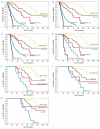Impact of the degree of anemia on the outcome of patients with myelodysplastic syndrome and its integration into the WHO classification-based Prognostic Scoring System (WPSS)
- PMID: 21659359
- PMCID: PMC3186303
- DOI: 10.3324/haematol.2011.044602
Impact of the degree of anemia on the outcome of patients with myelodysplastic syndrome and its integration into the WHO classification-based Prognostic Scoring System (WPSS)
Abstract
Background: Anemia is an established negative prognostic factor in myelodysplastic syndromes but the relationship between its degree and clinical outcome is poorly defined. We, therefore, studied the relationship between severity of anemia and outcome in myelodysplastic syndrome patients.
Design and methods: We studied 840 consecutive patients diagnosed with myelodysplastic syndromes at the Fondazione IRCCS Policlinico San Matteo, Pavia, Italy, and 504 patients seen at the Heinrich-Heine-University Hospital, Düsseldorf, Germany. Hemoglobin levels were monitored longitudinally and analyzed by means of time-dependent Cox's proportional hazards regression models.
Results: Hemoglobin levels lower than 9 g/dL in males (HR 5.56, P=0.018) and 8 g/dL in females (HR=5.35, P=0.026) were independently related to reduced overall survival, higher risk of non-leukemic death and cardiac death (P<0.001). Severe anemia, defined as hemoglobin below these thresholds, was found to be as effective as transfusion-dependency in the prognostic assessment. After integrating this definition of severe anemia into the WHO classification-based Prognostic Scoring System, time-dependent regression and landmark analyses showed that the refined model was able to identify risk groups with different survivals at any time during follow up.
Conclusions: Accounting for severity of anemia through the WHO classification-based Prognostic Scoring System provides an objective criterion for prognostic assessment and implementation of risk-adapted treatment strategies in myelodysplastic syndrome patients.
Figures



Comment in
-
If it ain't broke, don't fix it!Haematologica. 2011 Nov;96(11):e44. doi: 10.3324/haematol.2011.050872. Haematologica. 2011. PMID: 22058282 Free PMC article. No abstract available.
-
The degree of anemia has an impact on survival in myelodysplastic syndrome patients classified with WPSS.Haematologica. 2011 Dec;96(12):e45. doi: 10.3324/haematol.2011.056002. Haematologica. 2011. PMID: 22271927 No abstract available.
References
-
- Cazzola M, Malcovati L. Myelodysplastic syndromes--coping with ineffective hematopoiesis. N Engl J Med. 2005;352(6):536–8. - PubMed
-
- Swerdlow SH, Campo E, Harris NL, Jaffe ES, Pileri SA, Stein H, et al. WHO classification of tumours of haematopoietic and lymphoid tissues. Lyon: IARC; 2008.
-
- Malcovati L, Porta MG, Pascutto C, Invernizzi R, Boni M, Travaglino E, et al. Prognostic factors and life expectancy in myelodysplastic syndromes classified according to WHO criteria: a basis for clinical decision making. J Clin Oncol. 2005;23(30):7594–603. - PubMed
-
- Haase D, Germing U, Schanz J, Pfeilstocker M, Nosslinger T, Hildebrandt B, et al. New insights into the prognostic impact of the karyotype in MDS and correlation with subtypes: evidence from a core dataset of 2124 patients. Blood. 2007;110(13):4385–95. - PubMed
-
- Della Porta MG, Malcovati L, Boveri E, Travaglino E, Pietra D, Pascutto C, et al. Clinical relevance of bone marrow fibrosis and CD34-positive cell clusters in primary myelodysplastic syndromes. J Clin Oncol. 2009;27(5):754–62. - PubMed
Publication types
MeSH terms
LinkOut - more resources
Full Text Sources
Other Literature Sources
Medical

